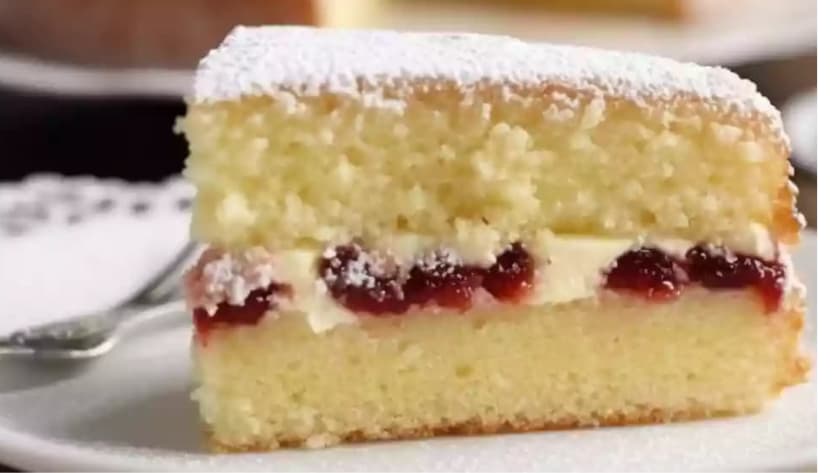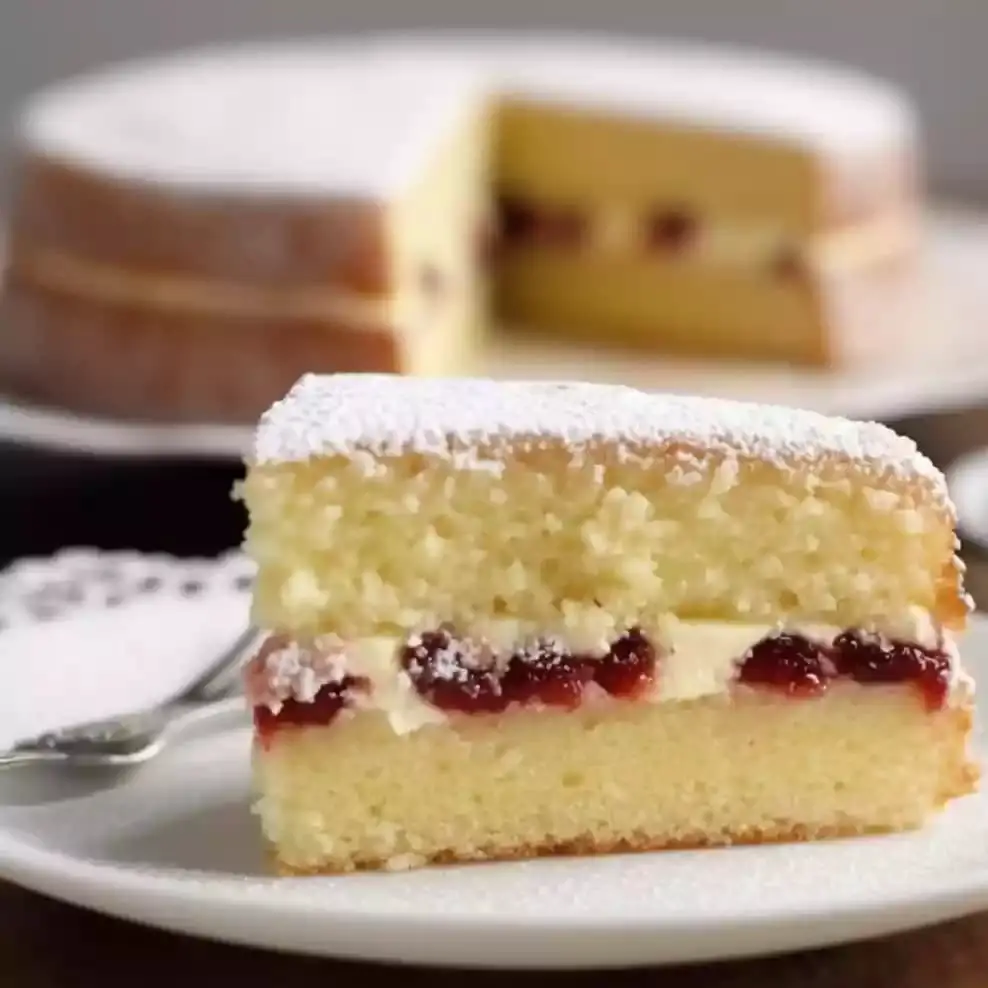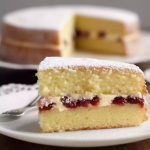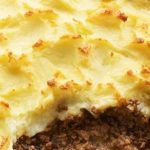James Martin’s Genoise Sponge Cake is a classic French-style sponge known for its light, airy texture. Unlike traditional sponges, genoise is made by whisking eggs and sugar over heat to create a fluffy base without using chemical leaveners like baking powder. This delicate cake is perfect for layering with fruit, cream, or buttercream, making it an ideal foundation for elegant desserts.
What is James Martin’s Genoise Sponge Cake?
A Genoise Sponge Cake differs from other sponge cakes by relying on air whipped into eggs for its rise, rather than baking powder or soda. The technique results in a light, tender crumb that’s ideal for layering or decorating. James Martin’s take on this classic recipe ensures a moist, fluffy sponge that can be the centerpiece of any dessert.

Other Popular Recipes
Ingredients Needed to Make James Martin Genoise Sponge Cake
- 4 large eggs
- 125g caster sugar
- 125g plain flour (sifted)
- 50g unsalted butter (melted)
- 1 tsp vanilla extract (optional)
- Pinch of salt
Instructions to Make James Martin Genoise Sponge Cake
Step 1: Preheat the Oven
Preheat your oven to 180°C (350°F). Grease and line the bottom of two 20cm (8-inch) round cake tins with parchment paper.
Step 2: Whisk the Eggs and Sugar
In a heatproof bowl, crack the eggs and add the caster sugar. Place the bowl over a pan of simmering water (double boiler), ensuring the water doesn’t touch the bottom of the bowl. Whisk the eggs and sugar constantly until the mixture becomes warm to the touch and the sugar is fully dissolved, about 3-4 minutes.
Step 3: Whip Until Fluffy
Remove the bowl from the heat and continue to whisk using an electric mixer or hand whisk at high speed. Whisk for about 5-7 minutes until the mixture triples in volume becomes pale, and forms ribbons when lifted. The batter should be light and fluffy.
Step 4: Fold in the Flour
Sift the plain flour and a pinch of salt over the egg mixture, and gently fold it in using a spatula. Be careful not to deflate the air that was whisked into the eggs. Add the vanilla extract (if using) during this stage.
Step 5: Fold in the Melted Butter
Once the flour is fully incorporated, gently fold in the melted butter. Be careful to fold slowly to avoid knocking out the air.
Step 6: Pour into Tins and Bake
Divide the batter evenly between the two prepared cake tins. Gently smooth the tops with a spatula and place the tins in the preheated oven. Bake for 20-25 minutes or until the cakes are golden and spring back when lightly pressed. A skewer inserted into the center should come out clean.
Step 7: Cool the Cakes
Remove the cakes from the oven and allow them to cool in the tins for 5 minutes. Then, turn them out onto a wire rack to cool completely before filling or decorating.

Pro Tips for Making the Best James Martin Genoise Sponge Cake
- Whisk the eggs properly: Ensure that the egg and sugar mixture is whisked until it’s pale and fluffy to trap enough air for a light sponge.
- Fold gently: When incorporating the flour and butter, fold gently to avoid deflating the batter, which is crucial for the cake’s airy texture.
- Avoid overbaking: The genoise sponge can dry out easily if overbaked, so keep an eye on it during the last few minutes of baking.
How Do I Store James Martin Genoise Sponge Cake?
Genoise Sponge Cake is best enjoyed fresh but can be stored in an airtight container at room temperature for up to 2 days. You can also freeze the unfilled sponge layers by wrapping them tightly in cling film and storing them in the freezer for up to 1 month. Thaw completely before decorating or serving.
Nutrition Value (per serving):
- Calories: 180
- Fat: 7g
- Carbohydrates: 23g
- Protein: 4g
- Sugar: 14g
- Fiber: 1g
FAQs
Why is my genoise sponge cake dense?
A dense genoise sponge is often the result of overmixing the batter or not whisking the eggs and sugar enough. To avoid this, whisk the eggs and sugar until pale and fluffy, and gently fold in the flour to retain the air that gives the cake its light texture.
Can I make genoise sponge without butter?
Yes, you can make genoise sponge without butter, but adding butter gives the cake a richer flavor and softer crumb. If you prefer a lighter version, simply omit the butter, but note that the texture may be slightly drier.
How do I prevent my genoise sponge from deflating?
To prevent a genoise sponge from deflating, make sure to fold the flour and butter gently into the whipped eggs and sugar. Avoid knocking out the air by using slow, careful folding motions. Also, be sure to bake the cake immediately after folding the ingredients.
Can I freeze genoise sponge cake?
Yes, genoise sponge cake can be frozen. Wrap the cooled layers tightly in cling film and store them in the freezer for up to 1 month. Thaw at room temperature before filling or decorating.
Final Words
This James Martin Genoise Sponge Cake Recipe is a light, airy cake that’s perfect for layering with whipped cream, fresh berries, or buttercream. Its delicate texture makes it a versatile base for many desserts, offering a sophisticated and elegant addition to any occasion. Enjoy!
More By British Baking Recipes
- James Martin Victoria Sponge
- Mary Berry 10-Inch Sponge Cake
- Mary Berry Yoghurt Cake
- Nigella Victoria Sponge
- Mary Berry Chocolate Sponge Cake

James Martin Genoise Sponge Cake
- Prep Time: 15
- Cook Time: 25
- Total Time: 40 minutes
- Yield: 8 1x
- Category: Dessert
- Method: Baking
- Cuisine: British
Description
A Genoise Sponge Cake differs from other sponge cakes by relying on air whipped into eggs for its rise, rather than baking powder or soda. The technique results in a light, tender crumb that’s ideal for layering or decorating. James Martin’s take on this classic recipe ensures a moist, fluffy sponge that can be the centerpiece of any dessert.
Ingredients
- 4 large eggs
- 125g caster sugar
- 125g plain flour (sifted)
- 50g unsalted butter (melted)
- 1 tsp vanilla extract (optional)
- Pinch of salt
Instructions
Step 1: Preheat the Oven
Preheat your oven to 180°C (350°F). Grease and line the bottom of two 20cm (8-inch) round cake tins with parchment paper.
Step 2: Whisk the Eggs and Sugar
In a heatproof bowl, crack the eggs and add the caster sugar. Place the bowl over a pan of simmering water (double boiler), ensuring the water doesn’t touch the bottom of the bowl. Whisk the eggs and sugar constantly until the mixture becomes warm to the touch and the sugar is fully dissolved, about 3-4 minutes.
Step 3: Whip Until Fluffy
Remove the bowl from the heat and continue to whisk using an electric mixer or hand whisk on high speed. Whisk for about 5-7 minutes until the mixture triples in volume, becomes pale, and forms ribbons when lifted. The batter should be light and fluffy.
Step 4: Fold in the Flour
Sift the plain flour and a pinch of salt over the egg mixture, and gently fold it in using a spatula. Be careful not to deflate the air that was whisked into the eggs. Add the vanilla extract (if using) during this stage.
Step 5: Fold in the Melted Butter
Once the flour is fully incorporated, gently fold in the melted butter. Be careful to fold slowly to avoid knocking out the air.
Step 6: Pour into Tins and Bake
Divide the batter evenly between the two prepared cake tins. Gently smooth the tops with a spatula and place the tins in the preheated oven. Bake for 20-25 minutes or until the cakes are golden and spring back when lightly pressed. A skewer inserted into the center should come out clean.
Step 7: Cool the Cakes
Remove the cakes from the oven and allow them to cool in the tins for 5 minutes. Then, turn them out onto a wire rack to cool completely before filling or decorating.



